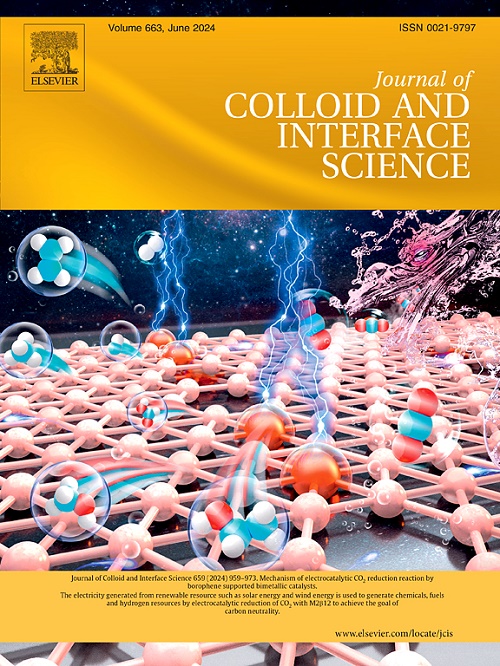Self-healing hyaluronic acid/polylysine hydrogel prepared by dual-click chemistry from polyrotaxane slidable crosslinkers
IF 9.4
1区 化学
Q1 CHEMISTRY, PHYSICAL
引用次数: 0
Abstract
A new type of pH-sensitive hydrogel containing supramolecular structures was fabricated from maleimide-functionalized polyrotaxane, ɛ-polylysine and furan-functionalized hyaluronic acid by Diels-Alder reaction and amino-maleimide reaction. Firstly, pseudo polyrotaxane was obtained through self-assembly of polyethylene glycol and α-cyclodextrin, and then capped with 1-adamantanecarboxylic acid to convert it into polyrotaxane. Secondly, a maleimide-functionalized slidable crosslinker was obtained by modifying the polyrotaxane with 3-maleimide propionic acid, and furan-functionalized hyaluronic acid was prepared by modifying it with 2-furanmethylamine. Thirdly, the hydrogel cotaining supramolecular structures was fabricated from the prepared slidable crosslinker, ɛ-polylysine, and furan-functionalized hyaluronic acid in mixed solvent of water and N,N-dimethylformamide. Taking gel mass fraction and swelling ratio as two indicators, the formation parameters of hydrogel were optimized through single- factor experiments. The pH-sensitivity, rheological properties, self-healing performance, and degradation behavior of the hydrogel were investigated. Cytotoxicity assay, live/dead stains, and hemolysis assay were done to verify the biocompatibility of the hydrogel. Finally, the slow-release behavior of the hydrogel containing lidocaine hydrochloride was studied. The hydrogel possesses good biocompatibility, pH-sensitivity, self-healing behavior, degradation, and drug-controlled release, and can find broad application in biomaterials.

通过双击化学方法,利用聚二十二烷可滑动交联剂制备自愈合透明质酸/聚赖氨酸水凝胶。
通过Diels-Alder反应和氨基马来酰亚胺反应,以马来酰亚胺官能化的聚骆驼祥烷、ɛ-聚赖氨酸和呋喃官能化的透明质酸为原料,制备了一种含有超分子结构的新型pH敏感水凝胶。首先,通过聚乙二醇和 α-环糊精的自组装获得了假聚龙齿杉烷,然后用 1-金刚烷甲酸封端使其转化为聚龙齿杉烷。其次,用 3-马来酰亚胺丙酸对聚罗他赛烷进行改性,得到马来酰亚胺功能化可滑动交联剂;用 2-呋喃甲胺对聚罗他赛烷进行改性,制备出呋喃功能化透明质酸。第三,利用制备的可滑动交联剂、ɛ-聚赖氨酸和呋喃官能化透明质酸,在水和 N,N-二甲基甲酰胺混合溶剂中制成含有超分子结构的水凝胶。以凝胶质量分数和溶胀率为两个指标,通过单因素实验优化了水凝胶的形成参数。研究了水凝胶的 pH 敏感性、流变特性、自愈合性能和降解行为。为了验证水凝胶的生物相容性,还进行了细胞毒性试验、活/死染色和溶血试验。最后,研究了含有盐酸利多卡因的水凝胶的缓释行为。该水凝胶具有良好的生物相容性、pH 敏感性、自愈合行为、降解性和药物控释性,可在生物材料中广泛应用。
本文章由计算机程序翻译,如有差异,请以英文原文为准。
求助全文
约1分钟内获得全文
求助全文
来源期刊
CiteScore
16.10
自引率
7.10%
发文量
2568
审稿时长
2 months
期刊介绍:
The Journal of Colloid and Interface Science publishes original research findings on the fundamental principles of colloid and interface science, as well as innovative applications in various fields. The criteria for publication include impact, quality, novelty, and originality.
Emphasis:
The journal emphasizes fundamental scientific innovation within the following categories:
A.Colloidal Materials and Nanomaterials
B.Soft Colloidal and Self-Assembly Systems
C.Adsorption, Catalysis, and Electrochemistry
D.Interfacial Processes, Capillarity, and Wetting
E.Biomaterials and Nanomedicine
F.Energy Conversion and Storage, and Environmental Technologies

 求助内容:
求助内容: 应助结果提醒方式:
应助结果提醒方式:


